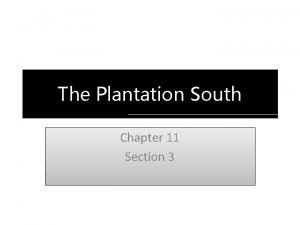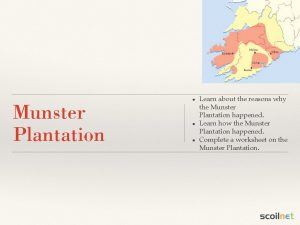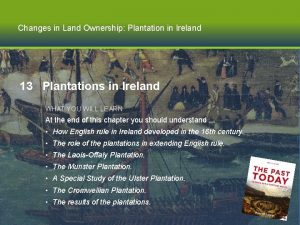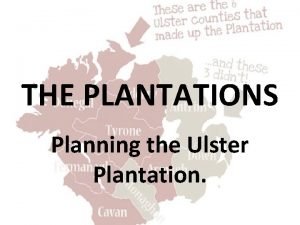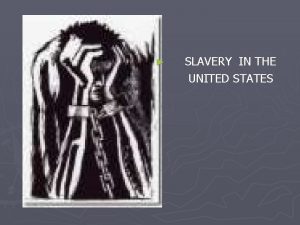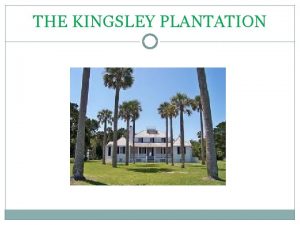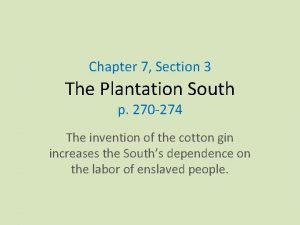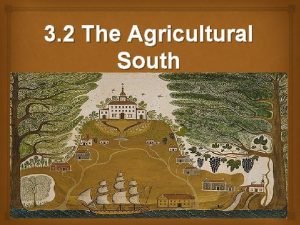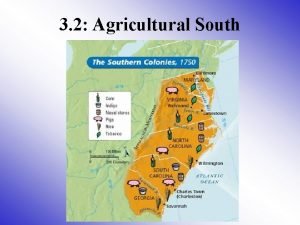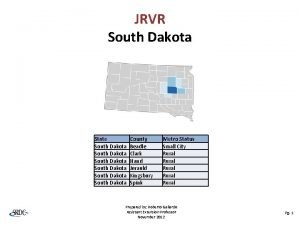The Plantation South Chapter 11 Section 3 Why


















- Slides: 18

The Plantation South Chapter 11 Section 3

Why It Matters • The Industrial Revolution brought change to both the North and South. • In the North, industry, immigration, and cities all grew. • But in the South, the economy became more dependent on cotton and slave labor.

The Cotton Kingdom • As the North became more urban and industrialized, the South remained largely rural. • Two events changed life in the South. First, a boom in textiles caused by the Industrial Revolution created a huge demand for cotton. • Second, a new invention allowed the South to satisfy that demand.

The Cotton Gin • In 1793, Eli Whitney devised a simple machine that speeded the processing of cotton. • His cotton gin used a spiked cylinder to remove seeds from cotton fibers. • Before the cotton gin, the seeds had to be picked out of the cotton fibers by hand. It was slow process to pick seeds by hand. A worker could only clean one pound of cotton a day.

The Cotton Gin • The cotton gin was revolutionary technology. A worker could process fifty times more cotton fiber with the gin then by hand. Cotton growing became more profitable.

Slave Labor • To grow more cotton, planters used more slave labor. In 1790, there were about 698, 00 enslaved African Americans in the U. S. • By 1860, the census recorded nearly 4 million enslaved African Americans. During that time, the price of a slave increased ten or twenty times. • Cotton became the greatest source of wealth for the U. S. It enriched planters in the South, as well as bankers and ship owners in the North.

Slave Labor • Cotton production rose at an astonishing rate. Planters grew one million pounds of cotton in 1790. In 1820, they grew ten times as much. • Southern states were not all alike. States like Alabama and Mississippi depended on cotton and therefore had large populations of enslaved people. • Kentucky devoted less attention to cotton and so fewer slaves lived there.

Slave Labor • In the southern “Cotton Kingdom, ” society was dominated by owners of large plantations. • This small but wealthy class lived in luxury and sent their children to the finest schools. • But more than half of all southern farmers did not have slaves. They grew corn and raised hogs and chickens.

Defending Slavery • Most southern whites accepted the system of slavery. Many feared that any weakening of controls over African Americans might encourage violent uprisings. • By the 1830 s, some people in the North were urging that slavery be banned. In response, southern whites hardened their support for slavery. • Supporters of slavery said it was more humane than the free labor system in the North. Unlike northern workers, they argued, enslaved African Americans did not worry about unemployment.

Defending Slavery • Critics of slavery challenged the South’s reasoning. They argued that northern workers were free to quit a job and take another if conditions became too harsh. • Also, the critics said, people held in slavery often suffered physical or other abuse from white owners.

African Americans in the South • Not all of the 4 million African Americans in the South were enslaved. About 6% were free. • Many had purchased their freedom. A few did well, especially in cities like New Orleans. But most did not share in the prosperity around them.

Restrictions on Free African Americans • Laws denied basic rights even to free African Americans. By law, they were excluded from all but the most menial jobs. • Their children were denied the right to attend public schools. African Americans could not vote, serve on juries, or testify against white defenders in court. • The freedom of African Americans in the South was never secure. Slave catchers prowled the streets looking for escapees. They often kidnapped African Americans and sold them into slavery.

Restrictions on Free African Americans • In spite of all the restrictions placed upon them, many African Americans made valuable contributions to southern life. • Norbert Rillieux revolutionized the sugar industry. His method of refining sugar made the process faster, safer, and less costly. • Another African American inventor, Henry Blair, developed a seed-planting device that reduced the time a farmer spent sowing a crop.

Life Under Slavery • Free African Americans faced many challenges but enslaved African Americans faced much greater trials. They had no rights at all. • Laws known as slave codes controlled every aspect of their lives. • Many enslaved African Americans became skilled workers. Their skills kept the plantations operating efficiently. Others worked in the owner’s homes as housekeepers, butlers, or nannies and became trusted house servants.

Life Under Slavery • The vast majority did heavy farm labor. Most slaveholders stopped short of working a laborer to death, but many have come close. • On large plantations, white overseers administered punishment by often whipping slave for many offenses. • Enslaved African Americans had only one real protection against mistreatment: Owners looked at them as valuable property that they needed to keep healthy and productive.

Life Under Slavery • Families of enslaved African Americans were often broken apart when slave owners sold one or more of their family members. • Many children had only the slightest memory of their parents. • After 1808, it was illegal to import enslaved Africans to the U. S. African American had little contact with their culture, yet customs such as music, and dance survived in their daily lives from one generation to another.

Life Under Slavery • Many African Americans found a message of hope in the Bible. African Americans composed spirituals, religious folk songs that blended biblical themes with the realities of slavery.

Resistance to Slavery • Many African Americans did what they could to resist the slaveholders. Some worked slowly or pretended not to understand what they were told to do. • Others deliberately broke farm equipment. The most daring fled to the north for freedom. • Sometimes resistance became rebellion. Nat Turner led the most famous slave revolt in 1831. Turner said he had a vision that told him to kill whites. • He was responsible for 60 deaths but there were many innocent African Americans executed in retaliation.
 Chapter 11 section 3 the plantation south
Chapter 11 section 3 the plantation south The munster plantation
The munster plantation Hey hey bye bye
Hey hey bye bye Plymouth plantation summary
Plymouth plantation summary Big creek plantation
Big creek plantation Bank of americk
Bank of americk Phdt nuwara eliya
Phdt nuwara eliya Bellgrade plantation
Bellgrade plantation Pecan front gate
Pecan front gate Ferry hill place
Ferry hill place Results of the ulster plantation
Results of the ulster plantation What is georgian tea like
What is georgian tea like Planning plantation
Planning plantation Most brutal plantation owners
Most brutal plantation owners Brightwood plantation in huger
Brightwood plantation in huger Davenport v cotton hope plantation
Davenport v cotton hope plantation Language techniques
Language techniques Forest plantation development sdn bhd
Forest plantation development sdn bhd Old south vs new south streetcar named desire
Old south vs new south streetcar named desire
